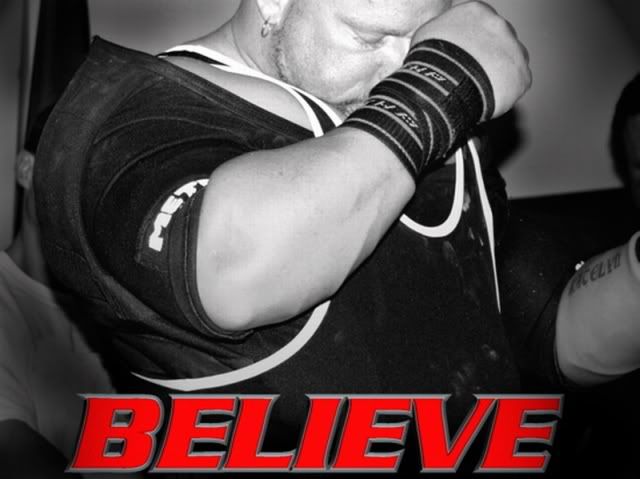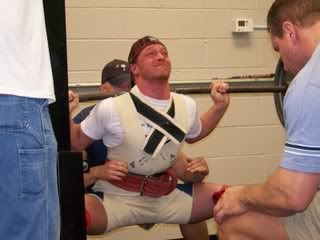Post by Joey Smith on Oct 25, 2007 23:14:45 GMT -5
The Intermediate Deadlift Cycle
By Mike Robertson
For www.EliteFTS.com
--------------------------------------------------------------------------------
The deadlift may be the purest test of strength in the iron game. Heavy weight. On the floor. Must pick it up.
In the beginning, you can follow just about any routine and make decent progress. Heavy sets of five have worked for more than a few lifters. However, once you get to the elite level, you must carefully plan your training cycle and figure out exactly which accessory lifts help drive your deadlift up.
Intermediate lifters fall somewhere in the middle of the road. They’ve generally used up their newbie gains so an unorganized or poorly progressed program will have them spinning their wheels. On the other hand, they’re not yet at an elite level so there’s no need to change max effort exercises and/or work up to heavy maximal lifts on a weekly basis.
Enter the intermediate deadlift cycle…
Implementing a modified max effort progression
I believe that if you want to pull heavy singles in a meet, you need to pull heavy singles in training. The deadlift is different from the squat. I know many high level squatters who have taken their squats to freakish levels with programs based around heavy sets of five. Brad Gillingham, Ed Coan, Kirk Karwoski, and Nick Tylutki are just a few that I can think of off hand. In contrast, I can’t think of any lifters who have taken their deadlift to an elite level using heavy sets of five.
The following routine gives you an idea of how to manipulate your program to start incorporating max effort deadlift work. I’m definitely not the first to write about max effort work, but I’ve used this program with multiple lifters (myself included) and seen great progress with it.
First and foremost, you need to pick 3–4 deadlift variations that you think will work for you. If you have no clue, you’re going to need to experiment and go through some trial and error. It’s good for you. Once you figure out what works, you’ll be better off moving forward.
Here are a few max effort variations that work well for the deadlift:
Mini-band resisted deadlifts
Deadlifts with bands
Snatch grip deadlifts
Sumo or conventional deadlifts (the opposite of what you would use in competition)
Rack pulls
Deadlifts standing on plates or boards
In the first week of your cycle, you’re “learning” the movement. I would work up to 3–5 moderate singles without any supportive gear. The goal here should be to have enough weight on the bar to feel the movement but not enough weight to where you need to get jacked up to lift it. Moderate is the key word here.
The second week is your true max effort day. You’ll use the same movement from the previous week, but this time you will do one of two things:
If you’re feeling good, belt up and go for a heavy single.
If you’re not feeling good, go ahead and belt up but work more in the 90–95% range. Two to three singles should be fine here.
In the third and fourth weeks, you’ll switch it up and use a different movement. I generally cycle 3–4 different max effort movements over the course of a training cycle. I then start over from the beginning. The obvious goal here is to hit a new PR each time you go back to a specific exercise.
A theoretical program
I know people will ask, “How do I integrate my squat and deadlift training into a weekly plan?” It’s a great question so let’s examine how I, personally, would set it up.
Remember, this is designed for an intermediate level lifter so if you’re not in this group, you may have to modify the plan as necessary. Elite level lifters in particular will always accumulate more training stress from any given session so they probably won’t be able to get away with this training program. This is why the elite often transition from two heavy leg days to one max effort session and one dynamic effort session.
I used this deadlift cycle in conjunction with my modified 5 X 5 squat cycle featured previously on T-Nation.
A cycle may look like this:
Monday, squat day Thursday, deadlift day
Week 1 4 X 5 at 70% Pulls against mini-bands
Week 2 5 X 5 at 80% Pulls against mini-bands
Week 3 3 X 3 at 65% Pulls with blue bands
Week 4 3 X 5 at 85% Pulls with blue bands
Here’s a quick rundown of how I’ve manipulated stress and recovery within this cycle. Week 1 is essentially a primer for week 2—getting the groove and accumulating some stress.
Week 2 is a big jump because your squatting volume and intensity are higher, and you’ll be working up to heavy singles on the deadlift. If you’re pushing yourself, you will be fatigued at the end of this week.
Week 3 is an unload week. The squatting volume and intensity go way down, and you’re getting prepped for a big week 4. I’ve always opted to go lighter than usual on this week if need be. The goal isn’t to be strong this week but the following week. Fatigue masks fitness. Remember that!
Week 4 is balls out—heavy squats and deadlifts. Crank up the Slayer and get diesel. Week 5 could be another unload or active recovery week before starting the cycle over. Quite often, I’ll just come in and do some speed or technique work on squats and pulls and call it a day. See how you feel and go from there.
Miscellaneous notes for optimal performance
If your technique sucks, you’d better get it straight ASAP. Many great articles discussing deadlift technique exist so read up and get it sorted out first and foremost.
At the intermediate level, you should have a basic idea of what supplemental exercises have a positive carryover to your deadlift. For example, if my glute ham performance is going up, my deadlift should be going up too. If you have no clue or need a refresher, check out my article titled, “Understanding Supplemental Exercises: The Deadlift featured previously on EliteFTS.com.
The deadlift may be the lift that takes the most swagger. I know I’ve said this before, but it bears stating again. You need to have the right attitude to deadlift heavy. I know many people who have deadlifted ridiculous weights with shitty form simply because they got pissed off and ripped the bar off the floor. I’m not saying technique isn’t important, but good technique with some attitude gives you the potential to deadlift freakish big weights.
If you’re an intermediate level lifter with no clue as to how to set up a cycle, you could do much worse than the one I’ve outlined above. Just remember that if you want to pull heavy singles on meet day, you need to prepare for it by pulling heavy singles in training.
Best of luck with your training and get stronger!
Mike Robertson, MS, CSCS, USAW, is the president of Robertson Training Systems and the director of Custom Athletics in Indianapolis, Indiana. Mike received his master's degree in sports biomechanics from the Human Performance Lab at Ball State University. To learn more about Mike, visit his website at www.RobertsonTrainingSystems.com and be sure to check out his products in the Elite store.
Elite Fitness Systems strives to be a recognized leader in the strength training industry by providing the highest quality strength training products and services while providing the highest level of customer service in the industry. For the best training equipment, information, and accessories, visit us at www.EliteFTS.com.
Copyright© 2007 Elite Fitness Systems. All rights reserved.
You may reproduce this article by including this copyright
and, if reproducing it electronically, including a link to
www.Elitefts.com.
By Mike Robertson
For www.EliteFTS.com
--------------------------------------------------------------------------------
The deadlift may be the purest test of strength in the iron game. Heavy weight. On the floor. Must pick it up.
In the beginning, you can follow just about any routine and make decent progress. Heavy sets of five have worked for more than a few lifters. However, once you get to the elite level, you must carefully plan your training cycle and figure out exactly which accessory lifts help drive your deadlift up.
Intermediate lifters fall somewhere in the middle of the road. They’ve generally used up their newbie gains so an unorganized or poorly progressed program will have them spinning their wheels. On the other hand, they’re not yet at an elite level so there’s no need to change max effort exercises and/or work up to heavy maximal lifts on a weekly basis.
Enter the intermediate deadlift cycle…
Implementing a modified max effort progression
I believe that if you want to pull heavy singles in a meet, you need to pull heavy singles in training. The deadlift is different from the squat. I know many high level squatters who have taken their squats to freakish levels with programs based around heavy sets of five. Brad Gillingham, Ed Coan, Kirk Karwoski, and Nick Tylutki are just a few that I can think of off hand. In contrast, I can’t think of any lifters who have taken their deadlift to an elite level using heavy sets of five.
The following routine gives you an idea of how to manipulate your program to start incorporating max effort deadlift work. I’m definitely not the first to write about max effort work, but I’ve used this program with multiple lifters (myself included) and seen great progress with it.
First and foremost, you need to pick 3–4 deadlift variations that you think will work for you. If you have no clue, you’re going to need to experiment and go through some trial and error. It’s good for you. Once you figure out what works, you’ll be better off moving forward.
Here are a few max effort variations that work well for the deadlift:
Mini-band resisted deadlifts
Deadlifts with bands
Snatch grip deadlifts
Sumo or conventional deadlifts (the opposite of what you would use in competition)
Rack pulls
Deadlifts standing on plates or boards
In the first week of your cycle, you’re “learning” the movement. I would work up to 3–5 moderate singles without any supportive gear. The goal here should be to have enough weight on the bar to feel the movement but not enough weight to where you need to get jacked up to lift it. Moderate is the key word here.
The second week is your true max effort day. You’ll use the same movement from the previous week, but this time you will do one of two things:
If you’re feeling good, belt up and go for a heavy single.
If you’re not feeling good, go ahead and belt up but work more in the 90–95% range. Two to three singles should be fine here.
In the third and fourth weeks, you’ll switch it up and use a different movement. I generally cycle 3–4 different max effort movements over the course of a training cycle. I then start over from the beginning. The obvious goal here is to hit a new PR each time you go back to a specific exercise.
A theoretical program
I know people will ask, “How do I integrate my squat and deadlift training into a weekly plan?” It’s a great question so let’s examine how I, personally, would set it up.
Remember, this is designed for an intermediate level lifter so if you’re not in this group, you may have to modify the plan as necessary. Elite level lifters in particular will always accumulate more training stress from any given session so they probably won’t be able to get away with this training program. This is why the elite often transition from two heavy leg days to one max effort session and one dynamic effort session.
I used this deadlift cycle in conjunction with my modified 5 X 5 squat cycle featured previously on T-Nation.
A cycle may look like this:
Monday, squat day Thursday, deadlift day
Week 1 4 X 5 at 70% Pulls against mini-bands
Week 2 5 X 5 at 80% Pulls against mini-bands
Week 3 3 X 3 at 65% Pulls with blue bands
Week 4 3 X 5 at 85% Pulls with blue bands
Here’s a quick rundown of how I’ve manipulated stress and recovery within this cycle. Week 1 is essentially a primer for week 2—getting the groove and accumulating some stress.
Week 2 is a big jump because your squatting volume and intensity are higher, and you’ll be working up to heavy singles on the deadlift. If you’re pushing yourself, you will be fatigued at the end of this week.
Week 3 is an unload week. The squatting volume and intensity go way down, and you’re getting prepped for a big week 4. I’ve always opted to go lighter than usual on this week if need be. The goal isn’t to be strong this week but the following week. Fatigue masks fitness. Remember that!
Week 4 is balls out—heavy squats and deadlifts. Crank up the Slayer and get diesel. Week 5 could be another unload or active recovery week before starting the cycle over. Quite often, I’ll just come in and do some speed or technique work on squats and pulls and call it a day. See how you feel and go from there.
Miscellaneous notes for optimal performance
If your technique sucks, you’d better get it straight ASAP. Many great articles discussing deadlift technique exist so read up and get it sorted out first and foremost.
At the intermediate level, you should have a basic idea of what supplemental exercises have a positive carryover to your deadlift. For example, if my glute ham performance is going up, my deadlift should be going up too. If you have no clue or need a refresher, check out my article titled, “Understanding Supplemental Exercises: The Deadlift featured previously on EliteFTS.com.
The deadlift may be the lift that takes the most swagger. I know I’ve said this before, but it bears stating again. You need to have the right attitude to deadlift heavy. I know many people who have deadlifted ridiculous weights with shitty form simply because they got pissed off and ripped the bar off the floor. I’m not saying technique isn’t important, but good technique with some attitude gives you the potential to deadlift freakish big weights.
If you’re an intermediate level lifter with no clue as to how to set up a cycle, you could do much worse than the one I’ve outlined above. Just remember that if you want to pull heavy singles on meet day, you need to prepare for it by pulling heavy singles in training.
Best of luck with your training and get stronger!
Mike Robertson, MS, CSCS, USAW, is the president of Robertson Training Systems and the director of Custom Athletics in Indianapolis, Indiana. Mike received his master's degree in sports biomechanics from the Human Performance Lab at Ball State University. To learn more about Mike, visit his website at www.RobertsonTrainingSystems.com and be sure to check out his products in the Elite store.
Elite Fitness Systems strives to be a recognized leader in the strength training industry by providing the highest quality strength training products and services while providing the highest level of customer service in the industry. For the best training equipment, information, and accessories, visit us at www.EliteFTS.com.
Copyright© 2007 Elite Fitness Systems. All rights reserved.
You may reproduce this article by including this copyright
and, if reproducing it electronically, including a link to
www.Elitefts.com.





